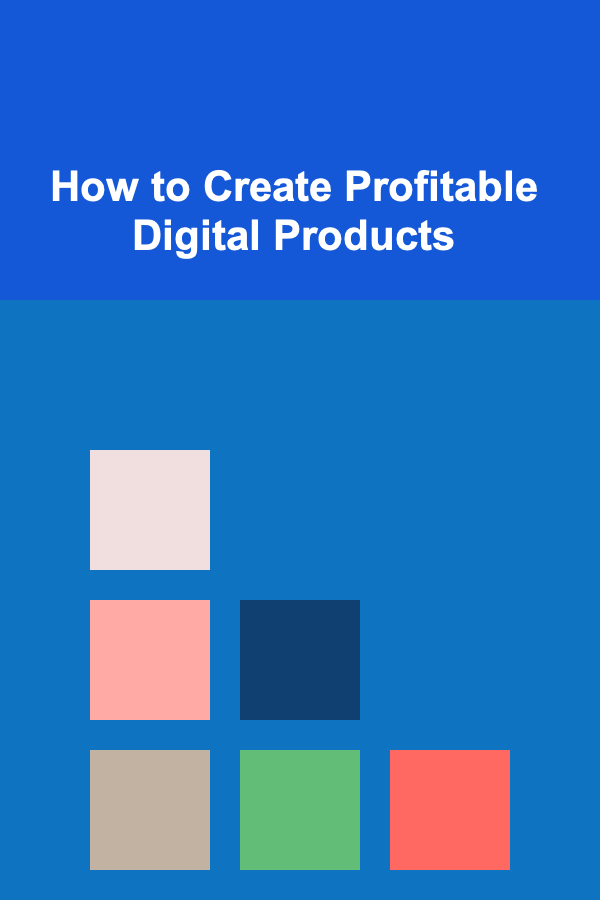
How to Create Profitable Digital Products
ebook include PDF & Audio bundle (Micro Guide)
$12.99$11.99
Limited Time Offer! Order within the next:

In today's rapidly evolving digital landscape, creating and selling digital products has become an increasingly viable and profitable business opportunity. Digital products, unlike physical ones, require no inventory, shipping, or storage costs, making them an attractive option for entrepreneurs. Whether you're an experienced business owner or just starting, learning how to create profitable digital products can pave the way to sustainable revenue streams and long-term success.
This article will guide you through the process of creating profitable digital products by discussing various types of digital products, the steps involved in creating them, the key elements that contribute to profitability, and strategies to market and sell them effectively.
Understanding Digital Products
Before delving into the intricacies of how to create profitable digital products, it's important to first understand what digital products are. In essence, digital products are intangible goods that are sold, downloaded, or accessed online. They do not require physical inventory and can be instantly delivered to customers, making them cost-effective and scalable.
Types of Digital Products
-
E-books
E-books are one of the most common digital products. They can range from fiction to nonfiction, offering valuable information, storytelling, or instructional content. E-books are relatively easy to create, require little upfront investment, and can be sold across various platforms like Amazon, Apple Books, and personal websites.
-
Online Courses
Online learning has gained immense popularity in recent years. Creating online courses in areas of expertise is a lucrative venture, especially when you're addressing a specific niche. Course platforms like Teachable, Udemy, and Skillshare provide all the tools necessary to create, market, and sell educational content.
-
Software and Apps
If you have programming skills or the means to collaborate with developers, creating software tools or mobile applications can be a highly profitable digital product. These products are in demand across various industries and can be monetized via subscription models, one-time payments, or freemium options.
-
Printables
Printables are digital files that users can download, print, and use for personal purposes. These could include planners, calendars, to-do lists, worksheets, and other organizational tools. The creation process is straightforward and typically requires graphic design skills.
-
Stock Photos and Graphics
Photographers and graphic designers can sell stock photos, illustrations, and graphic design templates. Websites like Shutterstock, Adobe Stock, and Etsy provide platforms to showcase and sell digital visual assets. This market is vast and caters to bloggers, marketers, and businesses in need of professional images and design elements.
-
Music and Audio Files
Musicians, sound designers, and podcasters can create and sell audio products such as soundtracks, beats, music loops, podcasts, and audio lessons. These products can be sold through music platforms like SoundCloud, iTunes, and Bandcamp.
-
Web Design Templates
Web design templates, WordPress themes, and website templates are valuable to businesses and bloggers looking for pre-made solutions to build their websites. If you have web design skills, creating and selling these templates is a highly profitable digital product.
-
Membership Websites and Subscriptions
A membership site allows users to access exclusive content in exchange for a recurring payment. Membership websites are ideal for individuals or companies who regularly produce valuable content, such as exclusive articles, webinars, video tutorials, and more.
How to Create Profitable Digital Products
The process of creating a profitable digital product involves several steps, from identifying a market need to launching and promoting the product. Below are the essential stages you'll need to go through to ensure your digital product is both high quality and commercially successful.
1. Identify a Niche Market
The first step in creating a profitable digital product is identifying a niche market. This involves understanding the needs, problems, or desires of a specific group of people. The more specific and targeted your niche, the easier it will be to design a product that meets the needs of that audience. A well-defined niche helps you avoid competition with larger, generalized markets and allows you to create a product that truly stands out.
To identify a niche:
- Research Market Trends: Use tools like Google Trends, Reddit, and online forums to identify growing interests or unresolved problems within various industries.
- Analyze Competitors: Look for gaps in the market by analyzing your competitors. Determine what they offer and what they don't.
- Leverage Your Expertise: If you have expertise in a specific field, consider creating a product that leverages your knowledge. Authenticity and authority in your niche will build trust with your audience.
2. Validate Your Idea
Once you've identified your niche, the next step is to validate your product idea. This ensures that there is a real demand for your digital product and that people are willing to pay for it.
Ways to validate your idea:
- Conduct Surveys: Use surveys to ask your target audience about their pain points and if they would be interested in your product.
- Launch a Minimum Viable Product (MVP): Create a simplified version of your product and offer it to a small audience for feedback. This allows you to test the waters and improve based on customer input.
- Pre-Sell the Product: Consider running a pre-sale campaign to gauge interest. If customers are willing to pay upfront for a product that doesn't exist yet, you can be confident that your idea has potential.
3. Create High-Quality Content
The quality of your digital product is the most important factor in ensuring profitability. A high-quality product will attract customers, build brand credibility, and encourage repeat sales.
- Focus on User Experience: Whether it's a course, an e-book, or an app, ensure that your product is easy to use and provides real value to your customers.
- Professional Design: The visual appeal of your digital product matters. Hire a professional designer if necessary to create polished, aesthetically pleasing content that resonates with your target audience.
- Comprehensive Content: Provide comprehensive, in-depth content that thoroughly addresses the problem or need of your audience. For example, an online course should be structured logically and offer practical, actionable lessons.
4. Automate Delivery and Payment Systems
One of the biggest advantages of digital products is that they can be delivered and sold automatically. This automation saves you time and allows you to scale your business more easily.
- Use Sales Platforms: Platforms like Gumroad, Shopify, or WooCommerce offer easy-to-use systems to sell and deliver digital products.
- Set Up Automated Payment Systems: Use payment processors like Stripe or PayPal to collect payments securely and automatically deliver your products after a purchase.
5. Pricing Your Digital Product
Pricing your digital product correctly is crucial to its success. Pricing too low can devalue your product, while pricing too high can discourage potential buyers. Consider the following when pricing your digital products:
- Research Your Competitors: Look at what similar products are priced at and gauge whether you can offer more value at a competitive price.
- Consider Your Costs: While digital products have low overhead costs, make sure you factor in the costs of marketing, platform fees, and any tools you need to create and maintain your product.
- Test Pricing Models: You can experiment with different pricing models such as tiered pricing, subscription models, or pay-what-you-want pricing to see what works best for your audience.
6. Market and Promote Your Product
Even the best digital products won't sell if no one knows about them. Effective marketing and promotion are key to driving traffic and generating sales. Here are several strategies to market your digital products:
- Content Marketing: Create blog posts, videos, or podcasts related to your product to attract organic traffic. Content marketing helps establish authority and drives awareness to your product.
- Email Marketing: Build an email list and use it to nurture relationships with potential customers. Email marketing campaigns are one of the most effective ways to promote digital products.
- Social Media Marketing: Leverage platforms like Instagram, Facebook, Twitter, and LinkedIn to showcase your products and engage with your audience. Social media also allows you to run paid ads to reach a broader audience.
- Affiliate Marketing: Partner with influencers or affiliates who can promote your product in exchange for a commission. This allows you to expand your reach with minimal effort.
7. Continuously Improve Your Product
The digital marketplace is highly dynamic, and customer preferences can change quickly. To remain profitable, you must continuously improve your products and adapt to new trends and technologies. Regular updates, new features, or complementary products can help keep your digital product relevant and increase customer satisfaction.
- Gather Feedback: Continuously ask your customers for feedback and use it to improve the product.
- Iterate: Regularly update the content or features of your product to address emerging needs or to maintain a competitive edge.
Conclusion
Creating profitable digital products is not just about having a great idea; it's about executing that idea in a way that resonates with your target audience, delivers real value, and stands out in a competitive market. By following a structured approach, from identifying a niche to creating high-quality content, automating sales processes, and using effective marketing strategies, you can create digital products that generate consistent revenue. In this digital era, with the right knowledge and strategy, you can turn your passion and expertise into a thriving online business.

How to Experience the Music and Culture of New Orleans
Read More
How to Pack for a Festival: A Checklist for Music, Fun, and Comfort
Read More
How to Plan a Successful Kitchen Remodel from Start to Finish
Read More
How to Set Up an Archive System for Old Documents
Read More
How to Understand Object Recognition in Augmented Reality (AR)
Read More
10 Tips for Displaying Art Prints in a Gallery Wall
Read MoreOther Products

How to Experience the Music and Culture of New Orleans
Read More
How to Pack for a Festival: A Checklist for Music, Fun, and Comfort
Read More
How to Plan a Successful Kitchen Remodel from Start to Finish
Read More
How to Set Up an Archive System for Old Documents
Read More
How to Understand Object Recognition in Augmented Reality (AR)
Read More